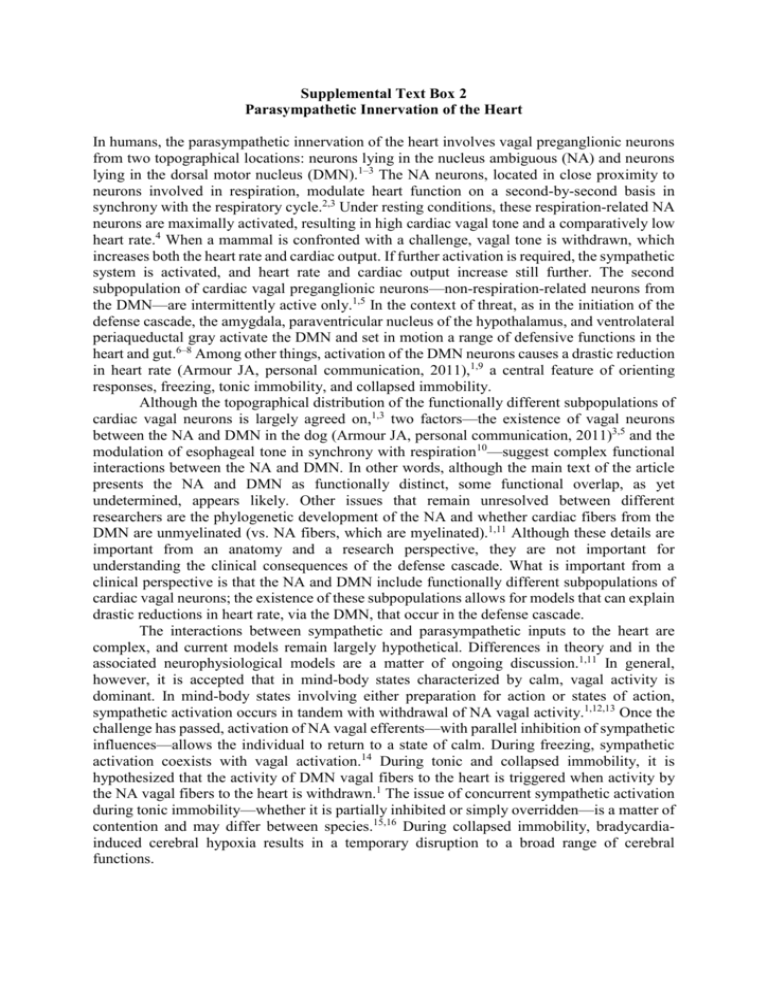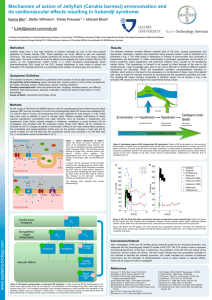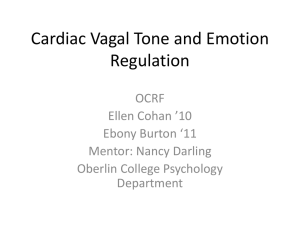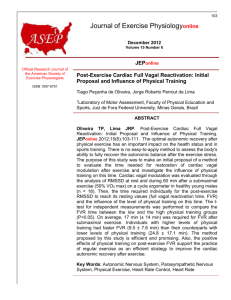Supplemental Text Box 2 Parasympathetic Innervation of the Heart
advertisement

Supplemental Text Box 2 Parasympathetic Innervation of the Heart In humans, the parasympathetic innervation of the heart involves vagal preganglionic neurons from two topographical locations: neurons lying in the nucleus ambiguous (NA) and neurons lying in the dorsal motor nucleus (DMN).1–3 The NA neurons, located in close proximity to neurons involved in respiration, modulate heart function on a second-by-second basis in synchrony with the respiratory cycle.2,3 Under resting conditions, these respiration-related NA neurons are maximally activated, resulting in high cardiac vagal tone and a comparatively low heart rate.4 When a mammal is confronted with a challenge, vagal tone is withdrawn, which increases both the heart rate and cardiac output. If further activation is required, the sympathetic system is activated, and heart rate and cardiac output increase still further. The second subpopulation of cardiac vagal preganglionic neurons—non-respiration-related neurons from the DMN—are intermittently active only.1,5 In the context of threat, as in the initiation of the defense cascade, the amygdala, paraventricular nucleus of the hypothalamus, and ventrolateral periaqueductal gray activate the DMN and set in motion a range of defensive functions in the heart and gut.6–8 Among other things, activation of the DMN neurons causes a drastic reduction in heart rate (Armour JA, personal communication, 2011),1,9 a central feature of orienting responses, freezing, tonic immobility, and collapsed immobility. Although the topographical distribution of the functionally different subpopulations of cardiac vagal neurons is largely agreed on,1,3 two factors—the existence of vagal neurons between the NA and DMN in the dog (Armour JA, personal communication, 2011)3,5 and the modulation of esophageal tone in synchrony with respiration10—suggest complex functional interactions between the NA and DMN. In other words, although the main text of the article presents the NA and DMN as functionally distinct, some functional overlap, as yet undetermined, appears likely. Other issues that remain unresolved between different researchers are the phylogenetic development of the NA and whether cardiac fibers from the DMN are unmyelinated (vs. NA fibers, which are myelinated).1,11 Although these details are important from an anatomy and a research perspective, they are not important for understanding the clinical consequences of the defense cascade. What is important from a clinical perspective is that the NA and DMN include functionally different subpopulations of cardiac vagal neurons; the existence of these subpopulations allows for models that can explain drastic reductions in heart rate, via the DMN, that occur in the defense cascade. The interactions between sympathetic and parasympathetic inputs to the heart are complex, and current models remain largely hypothetical. Differences in theory and in the associated neurophysiological models are a matter of ongoing discussion.1,11 In general, however, it is accepted that in mind-body states characterized by calm, vagal activity is dominant. In mind-body states involving either preparation for action or states of action, sympathetic activation occurs in tandem with withdrawal of NA vagal activity.1,12,13 Once the challenge has passed, activation of NA vagal efferents—with parallel inhibition of sympathetic influences—allows the individual to return to a state of calm. During freezing, sympathetic activation coexists with vagal activation.14 During tonic and collapsed immobility, it is hypothesized that the activity of DMN vagal fibers to the heart is triggered when activity by the NA vagal fibers to the heart is withdrawn.1 The issue of concurrent sympathetic activation during tonic immobility—whether it is partially inhibited or simply overridden—is a matter of contention and may differ between species.15,16 During collapsed immobility, bradycardiainduced cerebral hypoxia results in a temporary disruption to a broad range of cerebral functions. REFERENCES 1. Porges SW. The polyvagal theory: neurophysiological foundations of emotions, attachment, communication, and self-regulation. New York: Norton, 2011. 2. Taylor EW. The evolution of efferent vagal control of the heart in vertebrates. Cardioscience 1994;5:173–82. 3. Taylor EW, Al-Ghamdi MS, Ihmied IH, Wang T, Abe AS. The neuranatomical basis of central control of cardiorespiratory interactions in vertebrates. Exp Physiol 2001;86:771–6. 4. Hainsworth R. The control and physiological importance of heart rate. In: Malik M, Canmm AJ, eds. Heart rate variability. Armonk, NY: Futura, 1995:3–19. 5. Taylor EW, Jordan D, Coote JH. Central control of the cardiovascular and respiratory systems and their interactions in vertebrates. Physiol Rev 1999;79:855–916. 6. Leslie RA, Reynolds DJM, Lawes INC. Central connections of the nuclei of the vagus nerve. In: Ritter S, Ritter RC, Barnes CD, eds. Neuroanatomy and physiology of abdominal vagal afferents. Boca Raton. FL: CRC, 1992:81–98. 7. Kozlowska K. Stress, distress, and bodytalk: co-constructing formulations with patients who present with somatic symptoms. Har Rev Psychiatry 2013;21:314–33. 8. Wood JD, Alpers DH, Andrews PL. Fundamentals of neurogastroenterology. Gut 1999;45 Suppl 2:II6–16. 9. McCabe PM, Yongue BG, Porges SW, Ackles PK. Changes in heart period, heart period variability, and a spectral analysis estimate of respiratory sinus arrhythmias during aortic nerve stimulation in rabbits. Psychophysiology 1984;21:149–58. 10. Eastwood PR, Katagiri S, Shepherd KL, Hillman DR. Modulation of upper and lower esophageal sphincter tone during sleep. Sleep Med 2007;8:135–43. 11. Grossman P, Taylor EW. Toward understanding respiratory sinus arrhythmia: relations to cardiac vagal tone, evolution and biobehavioral functions. Biol Psychol 2007;74:263–85. 12. Levy MN. Cardiac sympathetic-parasympathetic interactions. Fed Proc 1984;43:2598– 602. 13. Vanhoutte PM, Levy MN. Cholinergic inhibition of adrenergic neurotransmission in the cardiovascular system. In: Brooks CM, Koizumi K, Sato A, eds. Integrative junctions of the autonomic nervous system. Tokyo: University of Tokyo Press, 1979:159–76. 14. Carrive P. Dual activation of cardiac sympathetic and parasympathetic components during conditioned fear to context in the rat. Clin Exp Pharmacol Physiol 2006;33:1251–4. 15. Vaddadi G, Esler MD, Dawood T, Lambert E. Persistence of muscle sympathetic nerve activity during vasovagal syncope. Eur Heart J 2010;31:2027–33. 16. Donadio V, Liguori R, Elam M, et al. Arousal elicits exaggerated inhibition of sympathetic nerve activity in phobic syncope patients. Brain 2007;130:1653–62.










